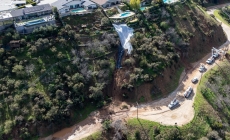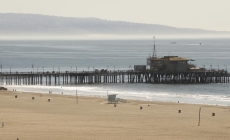-
New report looks at possible effect of ’90 Day Fiancé’ on visa approvals - October 30, 2023
-
A portion of Mulholland Drive, damaged by mudslides in winter storms, reopens - May 26, 2024
-
‘Maybe You Don’t Want to Win’ - May 26, 2024
-
Donald Trump Putting Law Enforcement in Danger: Attorney - May 25, 2024
-
Avoid the waters of these 5 L.A. County beaches this holiday weekend, public health officials say - May 25, 2024
-
Bawdy Comedy ‘Anora’ Wins Palme d’Or at Cannes Film Festival - May 25, 2024
-
Map Shows Heat Wave Zone Spread Into Five New States - May 25, 2024
-
Azusa police arrest suspected slingshot-wielding vandal - May 25, 2024
-
Donald Trump Hammers Judge Ahead of Jury Instructions - May 25, 2024
-
Sometimes U.S. and U.K. Politics Seem in Lock Step. Not This Year. - May 25, 2024
New report looks at possible effect of ’90 Day Fiancé’ on visa approvals
WASHINGTON, D.C. —
Since it first aired in 2014, TLC’s “90 Day Fiancé” has shown viewers the complexities of long-distance, international romances between U.S. citizens and people from foreign countries. But as the reality TV series has grown in popularity over the last decade, the approval rate for fiancé visas has dropped.
Those things could be linked, according to a report released Monday by Boundless Immigration, a tech company that helps people navigate immigration processes. The organization is looking into the ways in which the series might be affecting regular visa applicants, and says that while the show raised awareness about the visa process, it may have led to increased scrutiny of applications.
U.S. Citizenship and Immigration Services, however, said there isn’t any correlation between the show and the approval process.
“Requests for immigration benefits are not determined based on television entertainment or other forms of media content,” spokesman Matthew Bourke said.
“USCIS adjudicators individually evaluate every request for immigration benefits fairly, humanely and efficiently before issuing a determination,” Bourke said.
Viewership for “90 Day Fiancé” has steadily increased since the show launched in 2014, according to the report. Meanwhile, the approval rate for fiancé visas dropped nearly by a quarter, from 87% in fiscal year 2015 to 63% in 2022, according to U.S. Citizenship and Immigration Services data.
Before the show started, the approval rate was 75% in 2013. Data through the third quarter of this fiscal year show a 75% approval rate of applications processed so far. Still, Boundless Immigration said, the drop after “90 Day Fiancé” began airing is worth continuing to examine.
“The vast majority of Americans and even members of Congress would agree that keeping people in purgatory or keeping families from starting their lives together is probably not the best way of operating for the country,” said Boundless Immigration’s chief executive Xiao Wang, adding that the company has had clients who were featured on the show.
Representatives for TLC did not respond to requests for comment.
The K-1 visa is designed to reunite U.S. citizens with their foreign fiancés, giving them 90 days to get married before the visa expires.
But as with all immigration processes, the pandemic caused significant delays for fiancé visas. Early this year, the average processing time for the I-129F petition by the U.S. citizen fiancé for their foreign partner — a critical step in the visa process — ballooned to 21 months from seven months, according to the report.
On an episode of “90 Fiancé: Before the 90 Days,” participant Gino Palazzolo lamented how difficult it was leaving his partner, Jasmine Pineda, after he proposed to her in Panama.
“As soon as I got home, I filed the K-1 visa to bring Jasmine to the United States,” Palazzolo says on the episode. “But, you know, it’s taken a long time to process. We’re at, like, 12 months. So that makes Jasmine frustrated, because she wants to be with me now, and it causes friction between us.”
Though the show hasn’t led to an increase in fiancé visa applications, the backlog of applications waiting to be processed has more than doubled since before the pandemic to 51,500, according to U.S. Citizenship and Immigration Services data.
Although visa issuances have risen since 2020, they are still nowhere near pre-pandemic levels, according to the report. Fiancé visas make up less than half a percent of all yearly non-immigrant visa admissions.
Bourke of U.S. Citizenship and Immigration Services said the agency recently implemented changes to reduce the backlog of fiancé visa cases after the pandemic caused an agency-wide hiring freeze. Appropriations by Congress last year have been critical to reducing the backlog, he said, and proposed application fee increases would also help.
California is among the most common states for fiancé visa holders, as well as Texas, Florida and New York, according to the report.
Source link






























